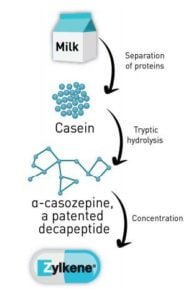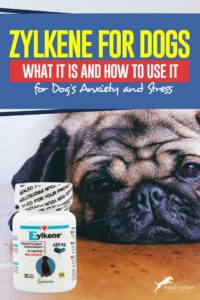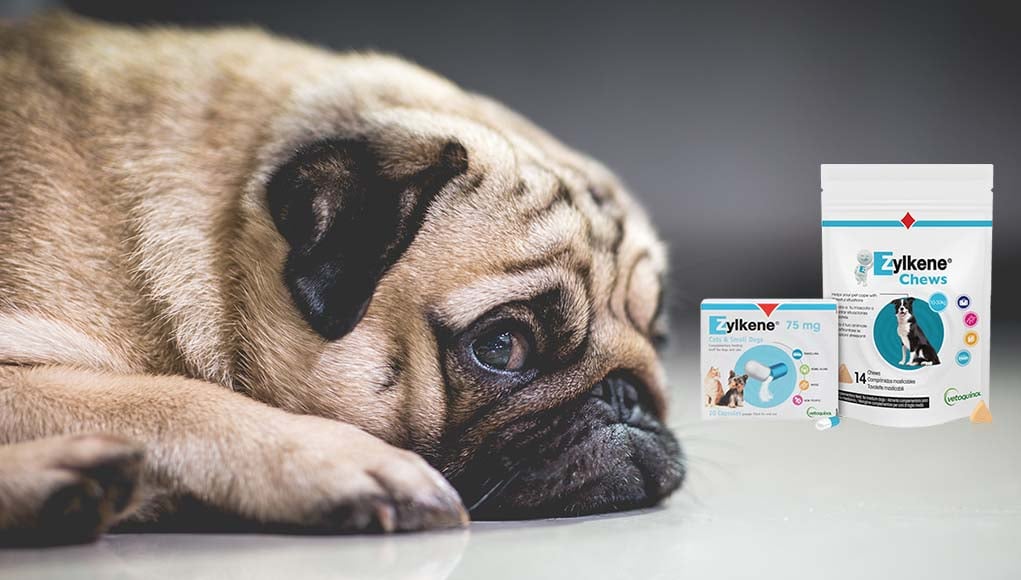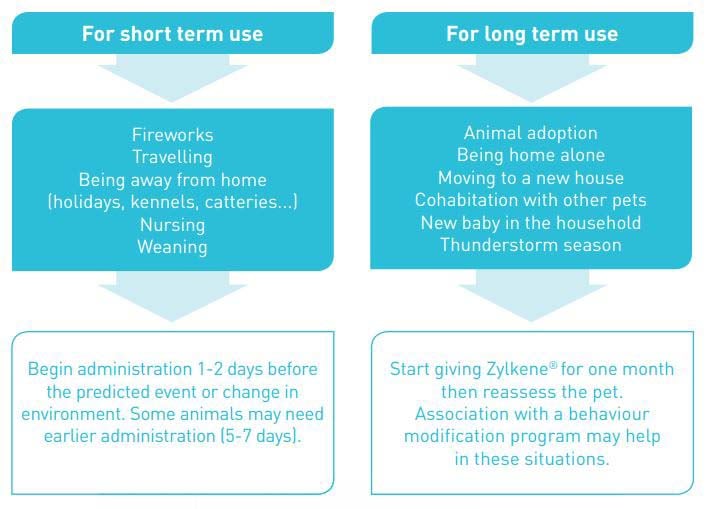Your dog's stress can be brought on by either a short term or a long term change. There are many ways to help your pet to cope with these different stressors, and their anxiety, including a wearable anti-anxiety vest, using a white noise machine, or through the use of anti-anxiety medication.
Zylkene is a natural way for dogs to cope with the various short and long term stressful situations. It can be administered in three different ways, it's safe for dogs, and has minimal side effects. If you feel the need to use it, here's everything you should know about Zylkene for dogs and how it can help your pup.
What is Zylkene?
Zylkene is a natural calming aid that can be administered to household pets in order to reduce stress and relieve anxiety. It is useful for both short and long term use, depending on your dog's anxiety triggers. The use of Zylkene for dogs is very popular because most owners and veterinarians prefer this brand over a number of other synthetic anxiety aids.
Zylkene can be used in conjunction with behavior training to help establish a sense of ease when a dog might be faced with multiple stressors or is prone to severe anxiety. If you are trying to decrease separation anxiety, it is suggested to work with a qualified behaviorist in addition to using Zylkene for dogs to ensure the best outcome. Zylkene is not recommended for dogs exhibiting aggression.
Active Ingredient: Hydrolyzed Milk Protein (Bovine).
Inactive Ingredients: FD&C blue #1 (capsule), Hypromellose (capsule), Magnesium stearate, Maltodextrin, Titanium dioxide (capsule).
Note that Zylkene is not a sedative or painkiller. It's made from a type of casein protein that is typically found in mammal’s milk, and which has anti-anxiety properties. Even though Zylkene is extracted from the proteins in milk, it can still be used by lactose-intolerant dogs because it is lactose-free.
How to Administer Zylkene for Dogs?
Zylkene can be given by using either chews or capsules in one of three methods:
1st method. Use a Zylkene capsule and sprinkle it on your dog's food. This can be done easily by taking the capsule apart over the pet's food and emptying the contents onto the meal.
2nd method. Give your dog a capsule or chew directly to consume. This method works best with the chews because dogs are less likely to eat the capsule, although some will eat the capsule with no problems at all (see here how to give a dog medicine).
3rd method. The third method is to dissolve it in your pup's water. This can be done easily by taking the capsule apart over the water bowl and emptying the contents into the water.
The Zylkene capsules contain a powder that is tasteless to dogs, which is why it can be sprinkled over food or dissolved into water. Zylkene chews, however, have a yeast flavor that most dogs like and they can be given as dog treats.
Both the capsule and the chew have the same calming results. If your pet is a picky eater, then you should probably choose the capsules; however, if they are food driven, the chew makes an excellent option.
Zylkene dosage for different dogs
There are recommended daily amounts of Zylkene for dogs that are based on the dog’s size for use with the capsule.
- For small dogs (up to 10 lbs), a dosage of 75 milligrams is suggested.
- For medium dogs (up to 20 lbs), a dosage of 225 milligrams is suggested.
- For large dogs (above 30 lbs), a dosage of 450 milligrams is suggested.
Short term and long term stressors (discussed below) also matter in the way you'll have to administer Zylkene for your dog.
If you know that anxiety stressors are coming and your dog will be anxious, and are intending to use Zylkene for dogs only for that short period, it is best to start administering the product to your pooch one or two days prior to the predicted event or environmental change that will cause your dog anxiety and stress.
When there's no specific event, and you are intending to use Zylkene long term, it is best to administer the product for one month, reassess your dog's stress levels after that, and continue treatment as needed or as recommended by your veterinarian or professionally qualified canine behaviorist.
What are Short Term Stressors for Dogs?
Short term stressors are things that can cause fear, panic, or anxiety in dogs for only a short period of time then go away on their own. Short term stressors include:
- Veterinary visits
- Traveling with your dog
- Fireworks nearby
- Hosting a party or noisy event at home
- Being left home alone for a longer period of time
- Holidays that bring visitors (such as Halloween)
- Guests or visitors who stay the night
- Visiting somewhere new
If you are expecting your dog to experience such a short term stressor, e.g. firework display on New Year’s Eve, then you should give Zylkene to your dog two days prior to the fireworks show.
What are Long Term Stressors for Dogs?
Long term stressors are things that can cause your dog to experience fear, panic, or anxiety for an extended period of time and do not simply disappear after a few days. Long term stressors may include:
- Packing or moving homes
- Introducing a new pet
- Introducing a new family member (baby or roomate)
- Extended pet boarding
- Loss of a family member or other pet
If you are expecting the dog to experience such a long term stressor, e.g. bringing a newborn baby home from the hospital, Zylkene can be administered as early as one month leading up to the event.
Is Zylkene Safe to Use with Dogs?
Zylkene is a safe supplement for dogs because it is a natural product. It's very often used by both owners and veterinarians. However, if you are interested in administering it to your puppy, pregnant, or lactating dog, you should definitely check with your veterinarian prior to use. Additionally, there are a few side effects to be aware of.
What Are the Side Effects of Zylkene for Dogs?
In rare, and extremely unlikely cases, your dog may experience some minor side effects after taking Zylkene. For instance, they may have diarrhea or vomiting. Your dog should not experience any drowsiness or fatigue after using the product.
The Best Zylkene for Dogs Brands
There's only one manufacturer of Zylkene for dogs that's currently available over the counter and is most popular with owners, and that's Vetoquinol. They have several “versions” of Zylkene for pets, but they're essentially the same (main ingredient is the natural milk protein). Their product is safe for both short and long term use, non-drowsy and has the NASC Quality Seal.
- Help Your Pet Cope With...
- Alpha-Casozephine - A...
- Lactose-Free and Easy on...
- Veterinarian Recommended Daily...
- Easy to Administer - Open the...
Alternative Calming Aids for Dogs
If for some reason Zylkene doesn't agree with your dog, or you would prefer to use a different brand of calming aids for dogs, there's several alternatives. Other than some of these popular over-the-counter anxiety medicines or those listed below, you can also experiment with non-oral treatments.
Other than behavioral training, many pet owners also had success in treating both short term and long term anxiety and stress in dogs using one or a combination of the below:
Sometimes, nothing other than medicine and supplements works. And for pet owners who would rather use chewable treats or capsules for stress and anxiety in their pet, here are some alternatives to Zylkene:
| Preview | Product | Rating | |
|---|---|---|---|

|
PREMIUM CARE Hemp Calming Chews for Dogs Anxiety,... | 49,265 Reviews | Check Price |

|
Zesty Paws Calming Chews for Dogs Composure &... | 16,944 Reviews | Check Price |

|
NaturVet Quiet Moments Calming Aid Dog Supplement,... | 54,968 Reviews | Check Price |
Signs That Your Dog is Stressed
Dogs exhibit a variety of symptoms when they experience stress and anxiety, either short term or long term. If you recognize that your dog is showing the following symptoms then they may need help coping with anxiety or stress.
- Excessive barking
- Weight loss
- Disturbance in sleep patterns
- Unusual social interactions
- Altered posture
- Toileting inside the home
- Withdrawn from regularly enjoyed activities
Here's a full infographic on all the signs of stress in dogs and how to recognize them.
Disclosure: We may earn affiliate commissions at no cost to you from the links on this page. This did not affect our assessment of products. Read more here and find full disclosure here.

















